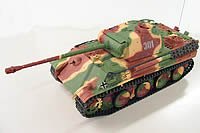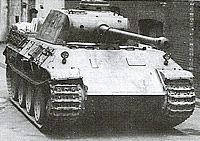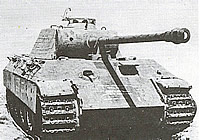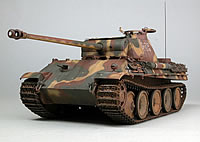|
|
Production Modifications Panzerkampfwagen
V Panther Sd.Kfz. 171
|  Tamiya's
Panther G Late Production Tamiya's
Panther G Late Production
|
For
most German tanks during World War II, modifications to the initial design were
frequently introduced during production runs to improve overall performance, simpify
manufaturing, or in response to material shortages. The aim of this page is to
provide useful information to tank modellers and enthusiasts, on key official
changes that affected its external appearance. Illustrations wll be provided where
available. It is not intended to be exhaustive and does not include the numerous
changes to the interior and internal components as well as unofficial modifications
made by crews in the field. The modifications are listed roughly in the order
in which they occurred headed by the component most affected. Approximate dates
are given where they are known.
Introduction
The
Panther tank was designed and developed as a direct result of the German tanks
being outgunned by the previous unknown Russian T-34/76 and KV-1 tanks encountered
during Operation Barbarossa, the invasion of Russia. It incorporates key design
features copied from the T-34 such as sloped armour, wider tracks and high velocity
overhanging main gun. It was put into production as the new standard medium tank
in a relatively short time. However it was introduced prematurely into Operation
Citdel, the Battle if Kursk, at Hitler's insistence. This led to numerous problems
and breakdowns as a result. Despite the insuspicious beginning, it was nevertheless
widely regarded as one of the best tanks used during World War II.
Panther
Ausf. D
The first production series of the Panther was designated the
model or Ausf D. About 850 Panther model Ds were produced in total. Main distinguishing
features are the drum-shaped commander's cupola, vertical letter box hatch for
the radio operator/machine gunner, communication and pistol ports around the turret,
smoke launcher on early models, twin headlights and twin aperture on mantlet for
binocular gun sight.
|
 Panther
Ausf. D
Panther
Ausf. D
|
Turret
& Cupola | The
first 20 Panther Ausf D had a turret with a large bulge in the left turret side
for the drum-shaped commander's cupola. The cupola was moved inboard to eliminate
this bulge in subsequent vehicles. Access was provided through hatches in the
cupola and the turret rear. An exhaust fan was mounted on the front right turret
roof. | Turret
Sides
| Vison
devices was provided for the crew inside the turret for all round viewing. The
gunner had a binocular gun sight and a small pistol pors to hisleft. The loader
had a pistol port to his right. The commander had all round vision blocks in the
cupola, a pistol port to his rear, and a communication port to his left. The communication
port was later eliminated. | | Turret
Smoke Launchers | Earlier
Panther Ausf Ds were fitted with twin smoke launchers either side of the turret
front. They were later eliminated when it was found that small arms fire could
set them off and smoke entering the tank through opened hatches could incapacitate
the crew. | | Escape
Hatch | The
escpae hatch was located to the rear of the turret offset on the right. |
Mantlet
&
Main Gun | The
Ausf D mantlet mounts a 7.5cm Kw.K.42 L/70 main gun and is distinguishable by
the two holes to the left of the gun barrel for the binoculor gun sight. A co-axial
MG34 machine gun is mounted to the right of the main gun. |
Bosch
Headlights | Earlier
Panther Ausf Ds were fitted with twin bosch headlight left and right of the glacis
plate just behind the front mudguards. The right headlight was later deleted as
an economy measure. | Driver
&
Radio Operator /
Machine Gunner | The
driver had direct vision through a rectangular port cut into the glacis plate.
When this is closed during battle, vision is provided by two fixed periscopes
on the super-structure roof.The radio operator /machine gunner likewise has a
vertical letter box port cut into the glacis plate through which he can fire the
MG34 machine gun. He is also provided with two fixed periscopes which mirror that
of the driver to his left. Two pop up and slide hatches on the superstructure
front roof provided access to the driver and radio operator / machine gunner. |
| Tool
Stowage | Tool
racks either side of the hull provided stowage for essential tools. A tube container
near the centre on the left hand side provided stowage for the gun cleaning tubes
and spare aerials. | | Spare
Tracks Holder | Spare
track links were carried on rack on the side of the rear hull beside the engine
deck. | | Gun
Travel Lock | A
gun barrel travel lock was installed on the centre front of the superstructure
roof above the cover for the exhaust fan. | | Production
Modifications | As
a result of battle experience, later Panther Ausf D have schurzen or armoured
side skirts fitted to protect the weaker side armour against Russian anti-tank
rifle fire. A ring mount was added to the commander cupola for an anti-aircraft
machine gun. 16 additional rivets were added to the 16 rim bolts to reinforce
the roadwheels. |
Panther
Ausf. A
The second production series of the Panther was designated
the model or Ausf A. About 2200 Panther model As were produced in total.
Main distinguishing features are the new cast commander's cupola with rail for
anti-aircraft machine gun, ball mount for front hull
machine gun,
anti-personnel grenade thrower on turret roof, Zimmerit paste on later models,
and single aperture on mantlet for monocular gun sight. |
 Panther
Ausf. A
Panther
Ausf. A
|
Turret
& Cupola | A
new turret was desigend for the Panther Ausf A but the chassis remain the same
as the Ausf D. The new turret incorporated a new cast cupola with seven all round
periscopes and a mounting rail for the MG34 anti-aircraft machine gun. a new fixed
periscope was also added to the turret roof for the loader. The new cupola was
retrofitted to the Ausf D. The hull is the same as Ausf. D. |
Close Defence
Weapon
|
An anti-personnel close quarter grenade launcher was mounted to the right rear
of the turret roof fro defence against attacking infantry above and around the
tank. | Ball
Mounted Hull Machine Gun
| The
letter box opening on the glacis plate was replaced by a ball mount for the hull
machine gun. Because the machine gun mount had its own sight, the forward looking
fixed periscope for the radio operator / machine gunner was eliminated |
Turret
Traverse
| The
main improvement of the Ausf A over the Ausf D was the variable speed turret traverse
drive tied to the engine which throrectically enable faster target acquisition
by the gunner. | | Rear
Hull Panel | Tow
coupling was added to the rear engine access hatch. This neccessitated the resiting
of the jack from a horizontal mount below the two exhaust pipes to a vertical
mount between the two exhaust pipes. Cooling
pipes added either side of the left rear exhaust pipe. |
| Zimmerit
Paste | Later
Panther Ausf A have Zimmerit, which is a concret-like paste, applied to the hull
and turret side to counter hand-placed magnetic anti-tank bombs used by Russian
soldiers. | | Production
Modifications | During
the Ausf A production run, the 3 turret pistol ports was dropped . The binoculor
gun sight in late Ausf A was replaced by a new monoculor gun sight so now only
one hole is visible on the mantlet for the gun sight. A rain guard was also added
above the gun sight opening to stop water getting into the turret. |
Panther
Ausf. G
The third and final production series of the Panther was designated
the model or Ausf G. About 2950 Panther model Gs were produced in total by the
time the assembly plants were captured by the allies in April 1945.
Main distinguishing features are the new 'chin' mantlet on later models, elimination
of driver's hatch and new periscope arrangement with new rotating driver's periscope,
new hull design with steeper side (to allow base hull to be used by the Jagdpanther),
new front hatches, new engine deck layout with raised crew heater on right air
intake fan. |
 Panther
Ausf. G
Panther
Ausf. G
|
| New
Hull Design | A
new simplied hull design with the side made from a single plate was introduced
for the Panther Ausf G. The sides had a steeper angle to allow the base hull to
be used by the new Jagdpanther in the planning stage. The rear deck was also redesigned
with new colling air intake and exhause louvres. The turret is the same as Ausf
A. | | Front
Hatches | New
hatches for the driver and radio operator / machine gunner that were hinged on
the outer side was installed. | Driver's
Periscopes
| The
driver's vision hatch and 2 fixed periscopes was replaced by a pivoting traversable
periscope. | | Rear
Hull Panel | Armour
guard shields were installed to protect the rear exhaust pipes. Mufflers were
also installed on the end of the pipes to hide exhaust flames from enemy at night. |
| Crew Heater | A
crew compartment heater was added over the right engine cooling fan to give the
distinctive raised tower featured on late-production Ausf. Gs. |
| Late 'Chin'
Gun Mantlet | A
new mantlet was introduced in later models with a 'chin' to eliminate the shot
trap that deflects incoming anti-tank fire into the hull. |
| Zimmerit
Paste | The
application of Zimmerit paste was eliminated when it was rumoured that it could
catch fire in some circumstance. This was never substantiated but nevertheless
the practice ceased towards the end of the war. | Other
Production Modifications | During
the Ausf G production run, A rain guard was installed over the driver's rotating
periscope. A debris guard was added between the mantlet and the turret to stop
dirt from falling in |
The
lower hull of the Panther G share many common features with the Jagdpanther on
which it was based.
Do
you find this useful? Is there anything you would like to add?
Email us your comments.
|
| |